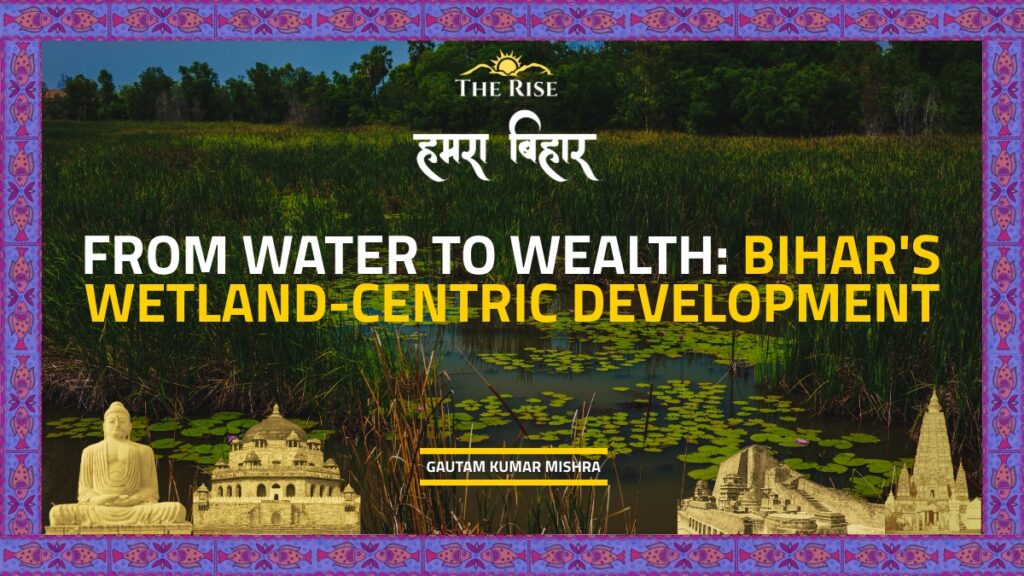Wetlands hold immense potential both in economic and ecological sense, but fragmented governance across departments and a lack of scientific monitoring create major challenges for the development of a wetland-centric economy. Without solving the governance issue, no wetland economy can take off.
Bihar has one of India’s richest networks of wetlands- oxbow lakes, floodplain wetlands, chaurs, mauns, and man–made water bodies, that shape the economic and ecological landscape of the state. The state hosts five Ramsar sites- Gokul Jalashay (Buxar) and Udaipur Jheel (West Champaran), Kabar Jheel (Begusarai), and Nagi and Nakti Bird Sanctuary (Jamui), each representing enormous ecological and livelihood potential.
This article explores the idea of shifting Bihar’s development model towards a wetland-centric economy, which means recognising wetlands as economic systems whose health directly shapes Bihar’s future growth. In this model, livelihoods do not extract from wetlands but strengthen and regenerate them, creating a cycle where ecosystems support people and people support ecosystems. This shift is central for Bihar, where a large share of the working population depends on agriculture, forestry, and fishing, making the adoption of the Sustainable Economic pathway more feasible.
Among the most promising sectors is fish farming, as Bihar’s floodplain wetlands are natural nurseries for major Indian carp species (a group of freshwater fishes used in aquaculture). When community groups adopt scientific stocking, cage culture, and seasonal harvesting, productivity rises without harming the water body. Fisher communities, by maintaining water quality, preventing dumping, and monitoring illegal encroachment, directly protect the wetland that sustains their income. Thus, conservation of these ecosystems becomes profitable, not burdensome.
Similarly, Mithila Makhana, which grows naturally in ponds and oxbow lakes, offers a low-input, high-value livelihood that depends entirely on clean and stable wetland ecosystems. Farmers benefit from nutrient-rich waters and, in turn, guard these waterbodies from pesticides or sewage inflow. The economic success of the crop, thus, becomes an incentive to protect the ecosystem it relies on. This reciprocity between land and water is at the heart of a wetland-centric development pathway.
Wetlands also hold enormous eco-tourism and cultural value. Kanwar Lake in Begusarai, Nagi-Nakti, Kusheshwar Asthan, and the Ganga Flood plain offer massive untapped tourism potential. Developing bird–watching circuits as Bihar’s wetlands host millions of migratory birds annually, along with Boating and Kayaking services, can promote and strengthen river-based tourism. When communities benefit from tourism, they become stewards of the landscape, ensuring cleanliness, biodiversity protection, and responsible visitation.
Wetlands hold immense potential both in economic and ecological sense, but fragmented governance across departments and a lack of scientific monitoring create major challenges for the development of a wetland-centric economy. Without solving the governance issue, no wetland economy can take off.
Bihar should come up with a clear policy vision for what a wetland–centric economy should look like. Wetland Economic Zones should be established, which would serve as a fisheries hub, a makhana hub, and an eco-tourism hub. Further, strengthening Panchayats and Jeevika groups is essential, as wetlands thrive when community institutions manage resources. The investment, both public and private, is required to strengthen ecotourism infrastructure, makhana processing, and the development of fisheries. This will make the wetland a growing economic sector rather than merely a conservation burden.
Conclusion
With both economic opportunity and ecological importance, Bihar stands at the crossroads of transformation. The wetlands, long treated as marginal landscapes, can become the foundation of a resilient, inclusive, and future-ready economy. Bihar can generate sustainable livelihood while safeguarding its natural heritage. With a clear policy vision, empowered institutions, and community-led governance, recognition of wetlands as productive natural capital will help Bihar truly move from water to wealth, turning its floodplains into engines of prosperity and climate resilience.
References
- Pandey, A., & Bharti, V. (2024). Wetlands in Bihar: A comprehensive analysis of extent, socio-economic significance, ecological benefits, and associated risks. CPP. https://doi.org/10.35782/JCPP.2024.1.07
- NITI Aayog. (n.d.). A macro and fiscal landscape of the state of Bihar. NITI Aayog. https://niti.gov.in/sites/default/files/2025-03/Macro-and-Fiscal-Landscape-of-the-State-of-Bihar-1.pdf.

